What is modified atmosphere packaging?
Author Dr. Bettina Plaumann
Modified atmosphere packaging (MAP) is a packaging and preservation technology that involves optimizing the gaseous atmosphere surrounding a food or other type of perishable product within a package to keep it fresh and increase its shelf life. Various methods and packaging materials are used to inhibit oxidation, respiration and slow down microbe growth.
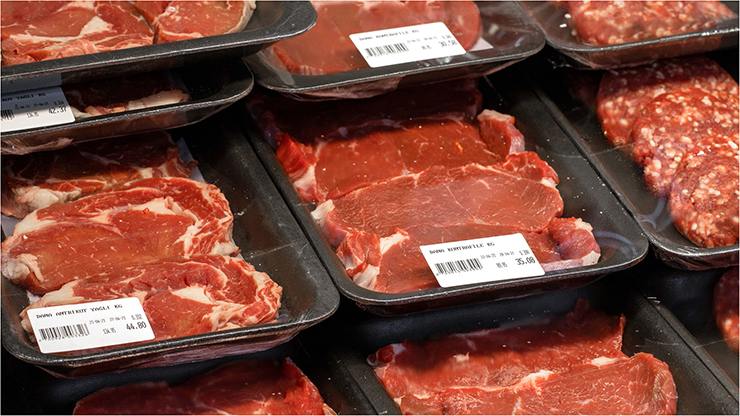
How does modified atmosphere
packaging work?
Oxidation, respiration and microbe growth are the core drivers of a shortened shelf-life of perishable products. All of these processes depend on the ratio of oxygen and carbon dioxide (or their absence) surrounding the product. Therefore, MAP packaging targets and optimizes this ratio to keep the products maximally fresh.
Good to know
The shelf life of a perishable product is the period in which the product is still acceptable for human consumption.
The ambient air is flushed out of the package and replaced by a different gas or a custom protective gas mixture. Most MAP gas mixtures include less oxygen, but much more nitrogen and/or carbon dioxide compared to ambient air. This is done to reduce bacterial reproduction, for example in cheese and other dairy products, or reduce the respiration rate of fruits and vegetables.
In contrast, certain other products such as beef can be packaged in a high O2-MAP procedure instead, which involves more oxygen compared to standard air. Oxygen is added to prevent discoloration.
There are 2 general types of modified atmosphere packaging: 1 – active and 2 – passive. We will introduce them in more detail and provide examples later. But first, we will take a closer look at the gases used in MAP packaging and their roles.
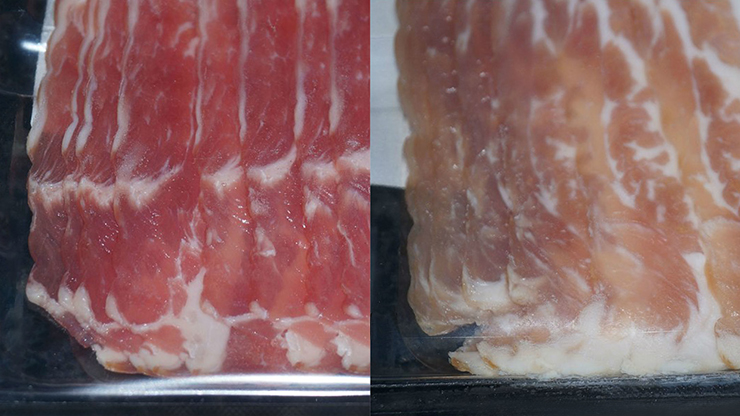
Gases used in modified
atmosphere packaging
The mixture of gases used in MAP packaging depends on various factors, such as the type of perishable product, the packaging materials, the storage temperature and the expected storage duration.
Oxygen
Oxygen is a highly reactive chemical. It is responsible for various chemical reactions and its presence accelerates microbe growth. In most cases, oxygen will facilitate food spoilage, so it should be excluded from MAP packaging. However, there are a few exceptions where adding oxygen into packages can have positive effects on the product’s shelf life.
Although individual cases can differ, one statement is generally true: Around perishable products, the reactivity of oxygen must be carefully managed.
Reducing oxygen in packages slows down lipid oxidation, browning and microbe growth, thus increases the shelf-life of most perishable products. On the other hand, increasing oxygen in packages helps red meat retain its red color and certain vegetables such as leafy greens retain their green color, texture and quality.
Carbon dioxide
Carbon dioxide decelerates microbe growth, as it can penetrate their cell membranes and hamper cellular respiration – a process necessary for microbe reproduction. This is why certain MAP packages, such as those for hard cheese, employ a 100% CO2 atmosphere.
However, using 100% CO2 is not always the best option, both for economical and chemical reasons:
- CO2 is more expensive to produce or source than nitrogen.
- Under certain conditions, CO2 can enter chemical reactions.
For example, it can react with water to form carbonic acid, which can slightly decrease the pH of the food. This can negatively impact the sensory properties and the shelf-life of certain foods.
Thus, CO2 is often used together with nitrogen in MAP packaging. In the case of red meat or certain vegetables, CO2 is used together with oxygen, which is needed for color stability, among other things.
Nitrogen
Nitrogen is a relatively inert gas that barely enters any chemical reactions with other substances. As such, it is used as a filler gas
to displace oxygen and form a protective atmosphere around the product. Because of its cheaper price and its high chemical stability compared to CO2, it is used to maintain the integrity of the package.
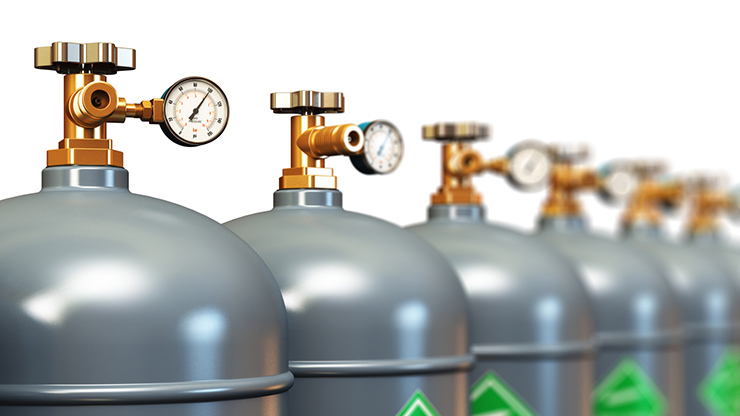
Noble gases
Noble gases such as Argon and Helium sometimes complement or replace nitrogen in MAP packaging. They are even more inert gases than Nitrogen and suitable for certain highly sensitive products such as fresh seafood. But their use is limited by their availability and cost.
Carbon monoxide
Some MAP packages for red meat contain a low concentration of carbon monoxide (e.g. <0.4%). This gas reacts with myoglobin, a protein responsible for the red color of meat. Their reaction forms carboxymyoglobin, a bright red pigment which is more stable and even more visually appealing than myoglobin. The presence of CO in red meat packaging also inhibits lipid oxidation, which increases shelf-life and decreases flavor deterioration.
The use of carbon monoxide is controversial because the substance is toxic to humans. However, the concentration of CO in MAP packaging is very low, which also minimizes risk of exposure (this argument applies to consumers, not necessarily to factory workers in the red meat industry). Nonetheless, it is banned in food packaging in the EU, Japan and some other countries. In the United States, the use of CO is permitted within certain thresholds, but its presence must be clearly labelled on packaging.
Examples of MAP gas mixtures for
different products
These gas mixes are just examples. Most terms describe a whole category of products, so the gas mixes represent simplifications. Individual gas mixes may differ.
| Oxygen (%) | Carbon Dioxide (%) | Nitrogen (%) | |
| Red meat | 70 | 30 | – |
| Poultry | 20 | 30 | 50 |
| Pork steak | 50 | 20 | 30 |
| Fish | – | 60 | 40 |
| Hard cheese | – | 100 | – |
| Soft cheese | – | 30 | 70 |
| Bread | – | 50 | 50 |
| Fresh pasta | – | 50 | 50 |
| Fruits & vegetables | 5 | 5 | 90 |
| Ready-made salad | 20 | 30 | 50 |
| Coffee | – | – | 100 |
| Liquid food and beverages | – | – | 100 |
| Carbonated soft drinks | – | 100 | – |
Types of modified atmosphere
packaging
The 2 general types of MA packaging are called active modified atmosphere packaging and passive modified atmosphere packaging.
Active modified atmosphere packaging
Active modified atmosphere packaging removes the gases in the package and replaces them with a new protective gas or protective gas mix.
Gas flushing
Gas flushing is the most common active modified atmosphere packaging method. It involves actively pumping gas into the package to displace ambient air. The most frequently used gas is nitrogen, which acts as a harmless, chemically inert filler gas. It inhibits oxidation and microbe growth, and maintains the integrity of the package.
Because of the prevalence of nitrogen as a protective gas, some sources refer to gas flushing as “nitrogen flushing”, or use the terms “gas flushing” and “MAP packaging” or “low oxygen packaging” as if they were synonyms.
However, this is an oversimplification. Depending on the perishable product and its properties, other gases may be used. Again, these include carbon dioxide, oxygen, certain noble gases or custom protective gas mixtures. Besides, gas flushing is not the only MAP packaging method.
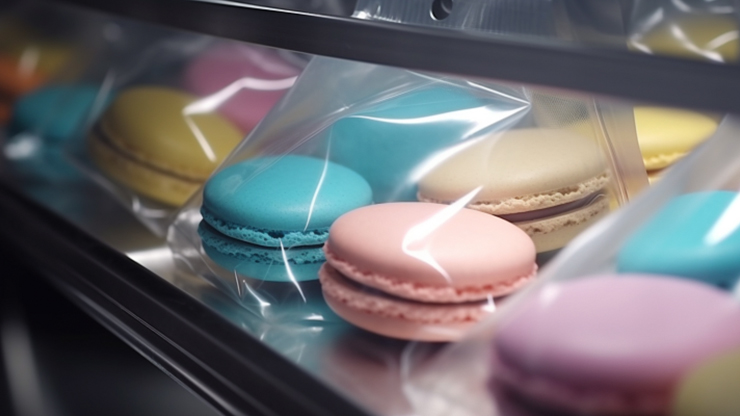
Scavenger or desiccant packs
Oxygen scavengers or desiccant packs often complement MAP packaging. Oxygen scavengers, also called oxygen absorbers, are sachets filled with iron powder designed to draw oxygen from the atmosphere. Desiccant packs are filled with substances such as silica gel or activated carbon. They intend to absorb moisture to prevent product degradation and inhibit microbe growth. Oxygen scavengers and desiccant packs each serve a separate purpose and cannot be used interchangeably.
It is debatable whether oxygen scavengers and desiccant packs
are actually a type of (active) modified atmosphere packaging. On the one hand, they do affect the atmosphere surrounding the food product. On the other hand, the gases and moisture the scavenger or desiccant packs absorb do not leave the package – they merely get concentrated in a small area within the package.
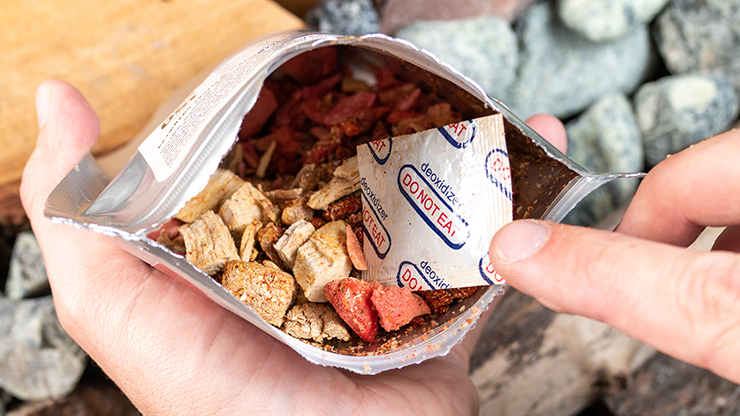
On-package valves
On-package valves are another active modified atmosphere packaging method: Small, one-way valves allow for the controlled release of gases from inside of the packaging to the outside. However, ambient air and moisture cannot enter the package from the outside.
On-package valves modify the atmosphere in the package to increase the product’s shelf life. They can also inhibit flavor and aroma loss, as well as prevent the package from bursting, if the perishable product is known to release a lot of gas. This is the case, for example, with coffee beans that tend to build up CO2. However, on-package valves are also applied on packages of other products, such as fresh vegetables and fruits, which require respiration.
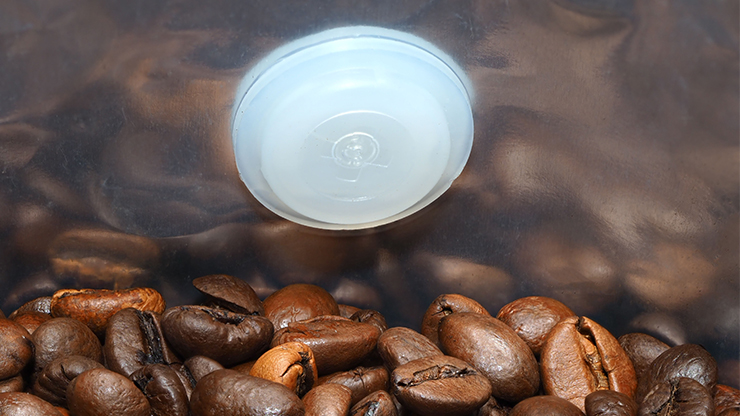
Passive modified atmosphere packaging
Passive modified atmosphere packaging employs “breathable” or permeable films which develop the desired atmosphere over time.
Barrier films
Barrier films are the “passive” way of achieving modified atmosphere packaging: “Breathable” films have their permeability fine-tuned to work in conjunction with the respiration rate of the product.
Their purpose is to change the ambient air in the package into an optimized atmosphere over time. Simultaneously, the barrier films inhibit oxygen and moisture from entering the package from the outside.
In the context of barrier films, a new technology is emerging: “Smart” packaging films, such as color-changing films that are spiked with pH-sensitive indicators, can detect problems in the package and aid in monitoring freshness. Smart barrier films are part of a larger subset of technology called “smart packaging” or “intelligent packaging”, which involve various change-sensitive devices to monitor product quality.
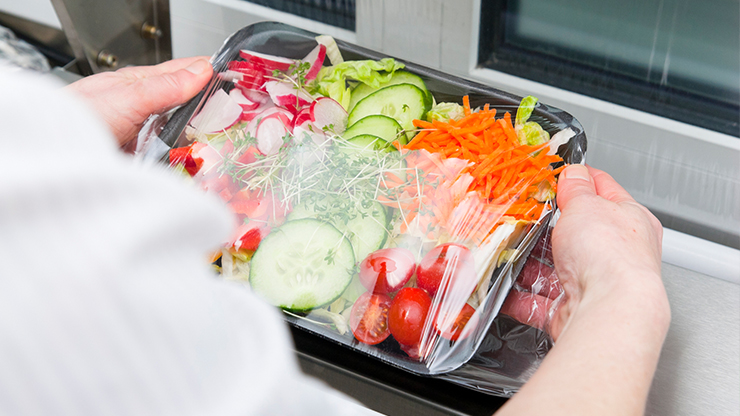
a barrier film
Vacuum skin packaging
In MAP packaging, the composition of the gaseous atmosphere around a product is changed, while in vacuum skin packaging, the atmosphere is removed altogether. Hence, vacuum skin packaging is not a type of MAP packaging, but it is somewhat similar.
Vacuum skin packaging is an ongoing trend in the market. Since it adds a visually appealing, glossy appearance to food, it is particularly well-suited to package premium meat, fish or seafood.
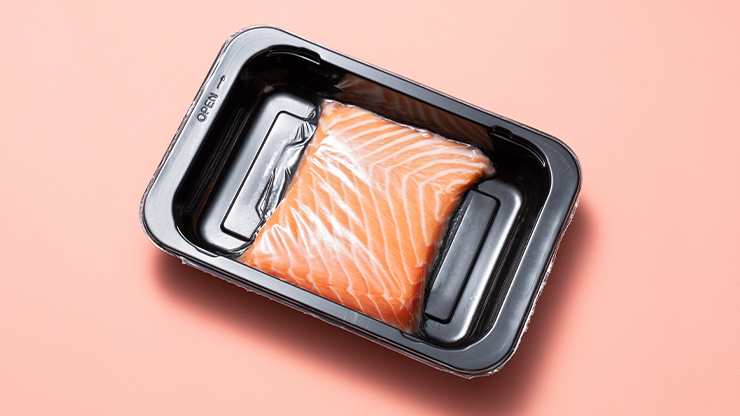
Materials used in modified
atmosphere packaging
Polyethylene (PE), the most common plastic used in packaging applications, exists in three main variants:
| Molecular structure | Properties | Applications | |
| High-density polyethylene (HDPE) | Linear | Stiff, opaque | Trays, bottles |
| Low-density polyethylene (LDPE) | Branched | Flexible, transparent | Films, shrink wrap, stretch wrap, pouches |
| Linear low-density polyethylene (LLDPE) | Linear | Flexible, transparent | Films, bags, liners, stretch wrap |
All types of PE have low gas barrier but excellent water barrier properties. Because MAP packaging is an application with high gas barrier requirements, PE is typically used in combination with another material. Certain types of modified PE are sometimes added for enhanced heat seal layer properties. This includes composites with aluminum.
Polyamide (PA), also known as nylon, has high tensile strength, puncture and abrasion resistance, as well as gas barrier properties. It is used in vacuum bags for fresh meat, among other things. To reach the desired heat seal layer properties, it is usually laminated with PE.
Polyethylene terephthalate (PET) is the most common polyester used in food packaging. Flexible PET films are used as bags or top films to cover trays. They feature excellent gas and moisture barrier properties, high rigidity, good optical properties (high transparency) and temperature resistance. Due to its higher glass transition temperature, the opaque Crystallized PET (CPET) is used in microwavable packaging for ready-made meals.
Polypropylene (PP) has good moisture but bad gas barrier properties. It can be used in flexible, rigid and semi-rigid packaging. PP is microwavable if it contains low-fat foods. However, in the presence of fatty foods, PP packaging would get too hot if microwaved.
Expanded polystyrene (EPS) has poor gas barrier properties. However, if laminated with EVOH, it can be used in preformed bottom trays for MAP packaging, where it functions as a structural layer.
Polyvinyl chloride (PVC) is an oil and fat resistant MAP packaging material with excellent processing characteristics. It is commonly used in combination with PE to thermoform bottom trays with the required heat seal layer properties. However, certain organic solvents can soften PVC and inhibit its gas barrier properties, so the packages have to be stored and handled appropriately to avoid contamination.
Polyvinylidene chloride (PVDC) is a copolymer of vinyl chloride and vinylidene chloride. It has outstanding gas, moisture and aroma barrier properties and is thus considered one of the best barrier materials for food packaging. It is resistant to oil, fats, organic solvents and high temperature. Its characteristics remain very stable, even in the presence of moisture. However, there is no currently established recycling method for PVDC and the material intensifies the yellowish tint in food packaging.
Did you know?
We offer a more sustainable alternative to PVDC.
Are you interested? Contact Kuraray and ask for EVAL™ EVOH, the polyolefin-recyclable monomaterial packaging solution, or PLANTIC™.
Innovative MAP packaging materials from
Kuraray
EVAL™ EVOH
Ethylene vinyl alcohol (EVOH) is a copolymer of polyvinyl alcohol (PVOH) and ethylene. While PVOH forms an excellent gas barrier, it is vulnerable to moisture. This is why the more moisture and solvent-resistant EVOH is the preferred choice as a MAP packaging material. EVOH also features a high mechanical and thermal stability. EVAL™ EVOH is the brand name of the ethylene vinyl alcohol copolymers (EVOH) produced by Kuraray. This material is well-suited for various paper and plastic packaging applications.
Example of a conceptual structure for such packaging: Polypropylene / EVOH / polypropylene. The production process comprises cast film coextrusion at very low temperatures in combination with the water quenching or chill roll quenching method. PP is a better water barrier than polyethylene (PE). Moreover, the multilayer structure with PP has better cold impact resistance than MAP trays with a conventional polyethylene terephthalate (PET) monolayer. A one-millimeter-thin EVAL™ EVOH film, laminated on another water-barrier forming polymer such as PP, can create a functional barrier that is equivalent to a ten-meter-thick polyethylene wall. Such a multilayer solution can form super-clear to white recyclable trays and replace PVDC in MAP packaging applications. Likewise, inserting a barrier layer of innovative EVAL™ SC resin between two layers of PE produces a shrink bag for fresh red meat that is both super transparent and recyclable.
PLANTIC™
PLANTIC™ is a high-performance film manufactured by Kuraray using more than 80% renewable raw materials. It is produced from thermoplastic starch and is biodegradable and compostable (home and industrial composting). Due to its high gas barrier properties, this biopolymer from Kuraray can be used in packaging that preserves aromas and effectively keeps out oxygen. PLANTIC™ is therefore ideal for both MAP packaging for food with a short shelf life and packaging solutions for dry goods such as coffee, tea and animal feed. PLANTIC™ is usually covered in a layer of polyethylene terephthalate (PET) and polyethylene (PE) as a moisture barrier and heat-sealable layer.
Example of a conceptual structure for such packaging: Polyethylene terephthalate / PLANTIC™ / polyethylene terephthalate or polyethylene. Dry lamination and extrusion coating are used to produce the tray. In near- infrared (NIR), PLANTIC™ barrier films have a unique fingerprint, so the trays can be assigned to any sorting stream based on local requirements. PLANTIC™ is produced as monolayer film for lamination or extrusion coating. Once washed away in the recycling process, PLANTIC™ biodegrades in the waste water treatment plant and does not cause contamination with microplastics.
Are you interested in our innovative materials for MAP packaging? Do not hesitate, contact us and ask for EVAL™ EVOH or PLANTIC™:
How to choose the right material
The suitability of materials in MAP packaging depends on various factors including:
- Food contact approval
- Gas and moisture barrier properties
- Mechanical properties (e.g. heat-sealing reliability, puncture resistance, tensile strength)
- Chemical resistance (e.g. to oils, fats, organic solvents)
- Optical properties
- Antifogging properties
- Processability
- Cost and availability
- Legal status (region-dependent)
- Recyclability
KURARAY’s packaging experts are happy to advise you.
Is modified atmosphere
packaging worth it?
Pros
- Longer shelf life
- Reduced spoilage
- Reduced microbe growth
- Increased form and texture stability
- Increased aroma and flavor stability
- Increased color stability
- Reduced need to use additives, artificial preservatives or food processing
- More sustainable due to reduced food waste and package waste
- No additional health risk to consumers
(read more)
Cons
- Capital cost of gas packaging machinery
- Cost of gases and packaging materials
- Cost of quality control equipment, both for monitoring the gas mixture and product quality
- Transport cost due to increased package volume
- Increased retail display space requirements
- In some markets, processed foods are in higher demand than fresh foods which decreases the need for MAP packaging
- Cannot fully replace other preservation methods, such as refrigeration
- Improper handling of MAP-packaged products, such filling in a polluted environment or breaking the cold chain, can lead to growth of food-borne pathogens
- If the package seal breaks, the benefits of MAP are lost
Whether modified atmosphere packaging is economically feasible ultimately depends on the increased duration of shelf life it provides to a perishable product relative to the cost of the packaging.
Our experts are happy to advise you.
Modified atmosphere packaging machines
There are 3 main types of machines used in MAP:
- Thermoforming MAP packaging machines
- Vacuum packaging machines
- Form fill seal machines
In the following section, we will introduce each of them briefly.
Thermoforming MAP packaging machines
Thermoforming MAP packaging machines are fed with a rigid plastic sheet to form package trays, and a flexible plastic sheet to seal them. The machines consist of a forming area, a filling area, a sealing area (for vacuuming and/or gas flushing), a printing and a cutting system. A tensioning system and a conveyor belt carry the film and the packages through these stages. Thermoforming MAP packaging machines are also known as Rollstock packaging machines or simply roll stock machines.
Thermoforming MAP packaging machine
Vacuum skin packaging machines
Vacuum skin packaging machines remove the air from the package and seal it. Recently, vacuum packaging has gained importance in the meat and fish packaging market as an alternative to MAP packaging. Seafood such as shrimps can also be vacuum packaged, resulting in an attractive gloss of the product inside the package.
Regarding MAP packaging, removing the air from a package is an important component of the MAP process and often the first step.
Vacuum skin packaging machine
Form fill seal machine
Form fill seal machines form and cut a pouch from a plastic film, fill it and seal it all in one system. They eliminate the need for expensive preproduced pouches – and they can accommodate MAP modules. There are two types: HFFS (horizontal form fill seal) and VFFS (vertical form fill seal).
Horizontal form fill seal machine (HFFS)
Monitoring
There are several things that need to be monitored in modified atmosphere packaging for quality control purposes. For example:
- Gas composition: The levels of oxygen, carbon dioxide, nitrogen and/or noble gases in the package have to be carefully monitored to optimize the product’s shelf life. If the desired gas composition is not met, it has to be adjusted or the shelf life is affected.
- Temperature: Despite the spoilage-inhibiting effect of MAP packaging, refrigeration remains crucial in the handling of perishable products. If the cold chain is broken during packaging, storage or transport, pathogens may grow and the food may not be safe for consumption.
- Packaging integrity: As the benefits of MAP packaging are lost when the packaging integrity is compromised, there is a variety of methods to monitor it. The most important ones include visual inspection, leak testing and pressure testing.
- Microbe growth: Spoilage microorganisms and pathogens pose a quality control problem in MAP packaging. Consequently, tests for specific pathogens, as well as the overall microbial load, are required.
- Shelf life: Even if a product and its package have passed all aforementioned tests, there can still be a discrepancy between projected shelf life and actual shelf life. Such cases have to be recorded and the cause identified. For example, it is possible that the gas composition had been fine initially, but the permeability of a barrier film changed it in unexpected ways, leading to a shortened shelf life.
To monitor MAP packaging quality, various tools can be applied. Examples include gas analyzers, headspace analyzers, package leak detectors and smart packaging.
Is Modified Atmosphere Packaging safe?
The protective gases in MAP packaging for meat products pose no additional risk to the health of consumers, according to the German Federal Ministry for Risk Assessment (BfR). Note that the use of carbon monoxide in food packages is forbidden in Germany.
Contact for business
We are looking forward to your inquiry!
